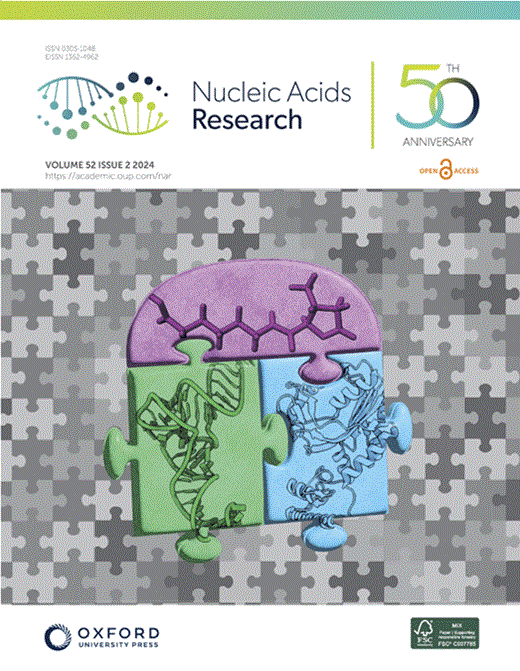Significance of the CTP-binding motif for the interactions of S. coelicolor ParB with DNA, chromosome segregation, and sporogenic hyphal growth
IF 13.1
2区 生物学
Q1 BIOCHEMISTRY & MOLECULAR BIOLOGY
引用次数: 0
Abstract
The segregation of bacterial chromosomes is widely mediated by partitioning proteins (ParAB). While ParB binds DNA specifically by recognizing short, palindromic sequences known as parS sites, ParA utilizes its ATPase activity to generate the force to translocate ParB–DNA nucleoprotein complexes (segrosomes). The assembly of the segrosome requires the association of ParB with parS, followed by nonspecific spread of the protein along the DNA. To spread on DNA, the ParB dimer must entrap the parS site within the complex, a process triggered by CTP binding to the conserved GERR amino acid motif. In Streptomyces, a genus of soil-dwelling, multigenomic bacteria that have a complex life cycle, ParB-dependent chromosome partitioning is initiated during the growth of sporogenic hyphae. However, the molecular mechanisms underlying segrosome formation in Streptomyces and their ability to coordinate with sporogenic development remain incompletely understood. In this study, we advance the understanding of chromosome segregation in bacteria by exploring the effects of CTP binding and hydrolysis on the formation of the partitioning complex in Streptomyces coelicolor. Here, via in vitro approaches, we demonstrate that a conserved GERR motif is essential for CTP binding and hydrolysis by S. coelicolor ParB. Moreover, the motif is crucial for CTP-dependent ParB accumulation on DNA. Using mutant strains, we show the significance of the GERR motif for segrosome complex assembly. Additionally, we provide data showing that the CTP-binding motif contributes to the regulation of the growth of sporogenic cells. Overall, we show that CTP-dependent segrosome assembly impacts the development of S. coelicolor sporogenic cells.ctp结合基序在S. coelicolor ParB与DNA、染色体分离和孢子生菌丝生长的相互作用中的意义
细菌染色体的分离是由分裂蛋白(ParAB)广泛介导的。ParB通过识别被称为parS位点的短回文序列特异性地结合DNA, ParA利用其atp酶活性来产生转移ParB - DNA核蛋白复合物(segrosome)的力。segrosome的组装需要ParB与parS的结合,然后是蛋白质沿着DNA的非特异性扩散。为了在DNA上扩散,ParB二聚体必须捕获复合物内的parS位点,这一过程是由CTP结合保守的GERR氨基酸基序触发的。链霉菌是一种生活在土壤中的多基因组细菌,具有复杂的生命周期,在产孢菌丝的生长过程中开始了parb依赖性染色体分配。然而,链霉菌中凝体形成的分子机制及其与产孢发育协调的能力仍不完全清楚。在本研究中,我们通过探索CTP结合和水解对coelicolor链霉菌中分配复合物形成的影响,促进了对细菌染色体分离的认识。在这里,通过体外方法,我们证明了一个保守的GERR基序对于S. coelicolor ParB的CTP结合和水解是必不可少的。此外,该基序对于ctp依赖性ParB在DNA上的积累至关重要。利用突变株,我们展示了GERR基序对凝体复合体组装的重要性。此外,我们提供的数据表明,ctp结合基序有助于调控产孢细胞的生长。总的来说,我们发现ctp依赖的segrosome组装影响了S. colcolcolor孢原细胞的发育。
本文章由计算机程序翻译,如有差异,请以英文原文为准。
求助全文
约1分钟内获得全文
求助全文
来源期刊

Nucleic Acids Research
生物-生化与分子生物学
CiteScore
27.10
自引率
4.70%
发文量
1057
审稿时长
2 months
期刊介绍:
Nucleic Acids Research (NAR) is a scientific journal that publishes research on various aspects of nucleic acids and proteins involved in nucleic acid metabolism and interactions. It covers areas such as chemistry and synthetic biology, computational biology, gene regulation, chromatin and epigenetics, genome integrity, repair and replication, genomics, molecular biology, nucleic acid enzymes, RNA, and structural biology. The journal also includes a Survey and Summary section for brief reviews. Additionally, each year, the first issue is dedicated to biological databases, and an issue in July focuses on web-based software resources for the biological community. Nucleic Acids Research is indexed by several services including Abstracts on Hygiene and Communicable Diseases, Animal Breeding Abstracts, Agricultural Engineering Abstracts, Agbiotech News and Information, BIOSIS Previews, CAB Abstracts, and EMBASE.
 求助内容:
求助内容: 应助结果提醒方式:
应助结果提醒方式:


